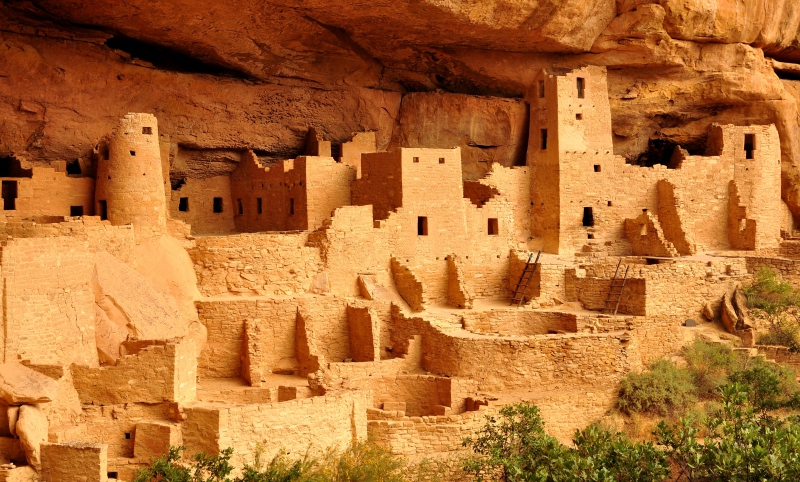
Scholar argues that historic landmark preservation law must address the impact of climate change.
Every year, thousands of tourists flock to see U.S. sites such as the Statue of Liberty in New York, Jamestown Island in Virginia, and Mesa Verde in Colorado. Although these historic landmarks hail from different eras and are located across the United States, they have one thing in common: they are all in danger of being damaged or destroyed by flooding, wildfires, erosion, and other climate change-related disasters.
Current historic preservation law will not be enough to save many treasured U.S. sites from damage due to climate change, argues Sara Bronin of Cornell University in a forthcoming paper.
Federal, state, and local governments can register historic sites through a criteria-based designation process. Criteria for designation vary depending on the jurisdiction but typically require demonstrating the historic significance and integrity of the site in question.
Integrity relates to the physical condition of a site and how it conveys its own historical importance. A site’s designation can be revoked if its integrity is degraded. Climate change harms the protection of historic sites because instability in the sites’ environments can impact their designations, Bronin argues.
Once a site has been designated as historic, the U.S. Secretary of the Interior’s standards regulate physical alterations to the site. These standards set guidelines for four treatments of historic sites: “restoration, preservation, reconstruction, and rehabilitation.” Standards for each treatment vary in what may be done to a historic site, but they all emphasize adherence to the original materials and design of historic sites.
Bronin claims that the U.S. Department of the Interior’s standards have a major impact at every level of preservation law. The National Park Service, state legislatures, tribal governments, and local districts have incorporated these standards into their laws and regulations.
Although the standards preserve historic sites, they also hinder efforts to protect sites from climate-related damage or to make them more environmentally friendly, Bronin argues. She claims that the standards are too strict because they overvalue the use of original material in treatments of historic sites.
The inflexibility of the standards frustrates attempts to ensure the longevity of historic sites and to reduce their environmental impact. For example, restoration projects under the standards require the use of original materials, which are more susceptible to damage from increasing temperatures, weather, or natural disasters.
The standards also do not include principles of sustainability or environmental responsibility. Moreover, the standards fail to provide exceptions for projects that would lessen the environmental impact of, or risk to, a historic site.
Bronin argues that this lack of explicit climate-related guidelines has hampered property owners’ attempts to address climate change. For instance, the Interior Department’s historic preservation standards prohibit raising buildings even when doing so to avoid flood damage from extreme weather or rising sea levels. The standards also prohibit moving historic sites to a new location even though for some sites moving them may be the only way to save them from destruction due to climate change.
In addition to the standards, the Park Service has released guidelines to clarify and contextualize the broad principles represented in the standards. Bronin claims that, although the guidelines do add specificity, they do not promote “climate-conscious preservation practice.”
Unlike the Interior Department’s standards, which outline a set of broad principles to evaluate the treatment of historic sites, the Park Service’s guidelines are more specific. Their specificity makes it more difficult for property owners to protect historic sites because the Park Service effectively bans the use of certain modern materials and practices, Bronin explains.
Like the Interior Department’s standards, the Park Service’s guidelines fail to address climate change explicitly. Bronin acknowledges that some more recent guidelines for the treatment of historic buildings have prioritized reducing energy use and increasing resilience. But she argues that these subtle changes are not enough and calls for more explicit guidance on how to respond to current climate threats for all types of historic sites.
The Park Service did release sustainability guidelines in 2011, but these guidelines only apply to the rehabilitation of historic buildings. Bronin argues that these guidelines are too narrow and do not fully address issues of sustainability. For example, because the sustainability guidelines fail to address raising buildings at risk of flooding, local officials interpret the guidelines as prohibiting doing so.
Overall, Bronin concludes that historic preservation law lacks explicit guidance about how to promote sustainability and protect historic sites from damage related to climate change. She recommends that the Interior Department revise its standards to give attention to climate change-related issues and provide guidance on techniques to mitigate and to react to the effects of climate change.



